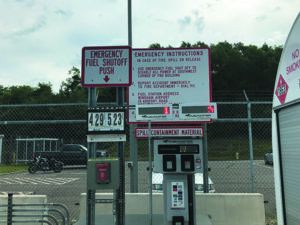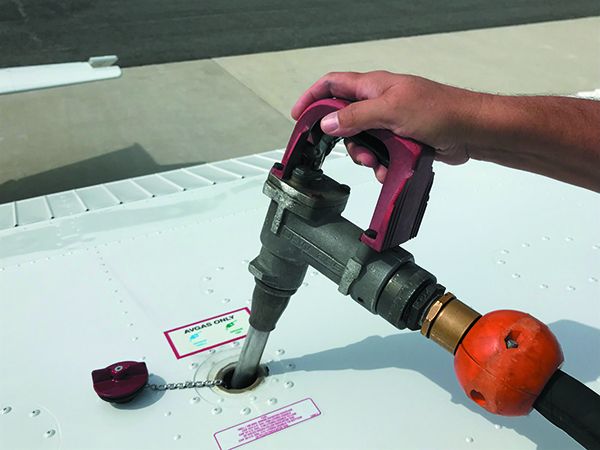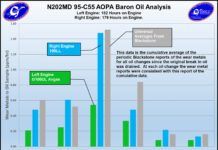In the March 2021 issue of Aviation Consumer, I started a lively discussion on the development of unleaded avgas—a topic that’s again on the EPA’s radar.
Several companies continue to work the engineering necessary to make unleaded avgas a reality for the majority of our GA aircraft engines. Here’s a continuation of the discussion, and some updates as we go to press in late spring 2021.
LYONDELL’S NEW PATENT
Last time, I summarized the unleaded avgas development efforts of GAMI, Lyondell Chemical/VP Racing, Phillips 66/Afton Chemical, Swift Fuels and Shell Global Solutions.
Since then, Lyondell’s unleaded avgas patent has surfaced, and it calls for an avgas that starts out much like today’s leaded avgas, with alkylate and isopentane. But then it’s adding 10 to 20 percent MTBE and ETBE (methyl tert-butyl ether and ethyl tert-butyl ether). These are the oxygenates initially used in mogas. But, MTBE has been outlawed from mogas in many U.S. states due to groundwater contamination concerns.
Modern avgas tankage is better controlled, so we wouldn’t expect much avgas in the groundwater. However, the ethers present a challenge due to water separation from avgas as the fuel cools at altitude, with the water then freezing to plug the fuel system. So Lyondell is also adding up to 5 percent methanol as an antifreeze to prevent water that drops out turning to ice.
But methanol presents materials compatibility concerns. Maybe it can be made to work in aluminum fuel tank airplanes with an appropriate corrosion inhibitor. Finally, Lyondell is adding about 250 mg/gallon of MMT, methylcyclopentadienyl manganese tricarbonyl. That’s about 30 times as much as used in U.S. mogas, and 10 times as much as used in Canadian mogas … even so, at those much lower additization rates, there were concerns here in North America about plug fouling due to MMT. Looking around the world for an example of 250 mg/gallon MMT usage, in Pakistan, the three oil companies (Shell, Total and the state-owned oil company) are using MMT at these high levels. However, Volkswagen is complaining to (and Honda is suing) the Pakistani oil companies selling MMT gasoline for the cost of warranty repairs that the fuel additive is causing.
As we used to say in graduate school, Lyondell’s approach has many moving parts. It’s a bit discouraging to see so many environmental tripwires included in what’s proposed to be the next aviation gasoline. There’s already been legislation against the ethers, and the environmental groups have been raising concerns about manganese.
PHILLIPS SWIFT, SHELL

The only update from Phillips is that although last November its online information sheet promised unleaded avgas commercialization in 2025 to 2026, the Gantt chart now shown on the www.trustedfuel.com unleaded avgas website shows 2026 to 2027.
Phillips is developing its fuel in conjunction with Afton Chemical, a subsidiary of NewMarket Corporation. Afton’s sister company is Ethyl Corporation, which markets tetraethyl lead for avgas. As reported at Oshkosh 2019, Phillips/Afton plan to add about 250 mg/gallon of MMT to their unleaded avgas. To make that work, an effective manganese scavenger must be developed.
As for Swift Fuels, I hoped it would join the discussion and offer more on the status of its high-octane unleaded avgas. I also have concerns about the distillation discontinuity of its proposed unleaded avgas, which should be a fixable problem. There’s also the question of economic viability. Swift’s CEO Chris D’Acosta took exception to our last report on its efforts, saying there were some errors, but when pressed for specifics, D’Acosta only identified that among the 17 Indiana companies named Swift (controlled by the Rusek family and D’Acosta), earlier work on Swift unleaded avgas was under a different Swift umbrella than the current Swift Fuels.
We offered Swift space in these pages to express its viewpoint and join our discussion, but at press time it hasn’t responded. We continue to wish them well, of course, and will report on any developments.
Shell Global Solutions has commented. “We are awaiting legislation on unleaded avgas and continuing to engage with relevant industry and government bodies on this topic.” We understand that to mean that following its unsuccessful engine testing efforts, Shell has ceased work on its unleaded avgas contender. Reading between the lines, my opinion is that its heavy-alcohol unleaded avgas effort could be dead. Moreover, I wonder if it just isn’t going to waste any more money on this effort until there’s a compelling business case.
Of course, it’s an awkwardly drafted comment. There is not likely to be any legislation on unleaded avgas—perhaps regulation sunsetting leaded avgas, and FAA acceptance of unleaded avgas. But, if Shell is truly awaiting legislation, it may be a very long wait indeed.
So efforts perk along on at least four of five fronts, and every one of those four companies has a reasonable chance of convincing the FAA they have a suitable unleaded avgas. Let’s wish the contenders well, and look forward to reasonably priced unleaded avgas that we can simply drop in to our existing aircraft. Better yet, and at least for a couple of the contenders, there could be some promise of even better performance going forward.
And by popular demand, here are some more questions, answers and some brainstorming. Keep the questions and comments coming. (Questions are in bold type, and the answer/discussion follow.)
So far, all the companies that are working on a new fuel say it will cost more to manufacture than 100LL. Can this really be true?
I don’t think that is true, but it’s a lengthy discussion with some unknowns. I have been there when Swift and GAMI spoke about higher manufacturing cost at Sun ‘n Fun and AirVenture at Oshkosh. Phillips was asked that question at AirVenture in 2019, and as I recall, the answer was it didn’t know yet. Shell has seemingly avoided the question. Lyondell hasn’t even been asked that question, as it sought to fly below the radar in the development effort.
But of course, maybe we don’t care (unless you’re a stockholder). The real question folks seek to understand is what will the price at the pump be? As noted above, that’s not clear, even if manufacturing costs more. Avgas is a fairly high-margin product, which is why anyone bothers with it today. So there’s some profit that could be sacrificed to stay competitive. It’s not like mogas, where you’ve got about 4 cents per gallon of margin to play with … it’s more like a buck a gallon for avgas.
There’s a whole other frontier here, though, that hasn’t been discussed much. Conventional avgas is very tied to prime fuels economics: The aviation alkylate is extracted from the mogas pool, as is the isopentane. In fact, the vapor pressure penalty imposed by the ethanol mandate has depressed isopentane prices, yay for aviation! But, too bad it’s such a small part of the avgas gallon.
The Swift and GAMI formulations, and to a lesser extent Lyondell’s and Shell’s, include materials that trade in the chemicals marketplace. And chemicals have different price sensitivities than commodity fuels. To give an example, if crude prices drop, prime fuels (gasoline, jet, diesel), which are very cost competitive, will follow that pricing downward. If this happens during an economic expansion, though, chemicals trend upward, since they are the raw materials of so much manufacturing including plastics, paints, etc. This pricing crossover was a constant tension in the big refinery, as you would modify operations to optimize chemicals over fuels in an expansion—or modify operations to optimize fuels over chemicals in a recession. And we would try to guess on a day-by-day basis which was really happening at the moment.
As avgas buyers, we’re kind of accustomed to seeing avgas slowly follow mogas pricing downward, and rapidly follow mogas pricing up. (There are supply and demand reasons for the different speeds, or you can put on your tinfoil hat and allege a conspiracy.) In the brave new world of Swift (roughly 80 percent chemicals), GAMI (roughly 30 percent chemicals), Lyondell and Shell (roughly 20 percent chemicals), we might see avgas pricing that defies historic trends. When OPEC loses control, crude prices fall and an economic expansion ensues, we’ll see mogas falling but avgas rising, maybe.
Note that the sensitivities noted above do NOT contradict any of the claims that the fuel components come from the fuels refinery … it is just that the components that we’re interested in for unleaded avgas have alternate homes in the chemicals marketplace, and that will drive their alternative-use pricing.
That is how folks look at avgas cost today—it’s a classic operations research problem. You feed three things, you make 15 products, how do you assign costs and overhead among the elements? For avgas, it’s fairly straightforward in the industry as folks look at the alternative disposition.
If avgas demand stopped tomorrow, what would we do with these components? For 100LL, the alkylate (about 60 percent to 80 percent of the blend) would make more reformulated gasoline. In fact, each decremental gallon of avgas would allow upgrading three gallons of conventional gasoline to higher-priced reformulated gasoline. The next piece depends on what a refiner uses for HOBS, high octane blend stock. If it’s toluene, it is directly priced off the chemicals market, it’s very fungible and the market is large. If it’s reformate, it gets trickier—maybe it gets diverted to mogas. Or, maybe there’s a different opportunity: Change operation of your naphtha reformer, decrease severity to lower octane, but increase liquid yield (make more gallons of gasoline). This may require plant modification, but if you don’t need to make avgas, that modification is probably a good investment. The isopentane and additive package are just commodities. There’s no volume sensitivity affected by the relatively small avgas production.
A new replacement fuel will be more expensive. The question is how much more will it cost? $7 to $10 dollars per gallon? Why does everyone assume it will retail for more? Right now, you have one or two companies making the lead additive, which they sell to someone else to make the batches of 100LL. Government costs on top of lead? Regulatory, tax, hazardous materials, etc. They don’t mix avgas on a regular basis; they make a big batch, which incurs storage costs. Then you have to have dedicated distribution systems.
Pipelines, trucks/trains, storage tanks, pumps. If the new fuel can use automotive distribution systems, then that cost is removed. If the new fuel can be mixed/created more frequently, then storage costs can be reduced. If there is a special additive, perhaps the manufacture is less costly and onerous than lead.
I don’t know if it’s comforting, but I can reject all of your hypotheses and still agree with you! Any avgas will require dedicated distribution, due to product integrity issues. Unleaded avgas will still be batch blended, so the frequency and size of batches is really driven by economics, not fuel composition. The cost of lead isn’t a major contributor to avgas cost: around 5 to 10 cents per gallon, depending on how clever your avgas blender is at negotiating with that sole supplier of TEL (tetraethyl lead).
It seems you could make a case that avgas stays the same price or becomes cheaper, while still providing enough margin to give the inventor a nice royalty, no?
What would drive avgas price down is new entrants. There are lots of smaller blenders who could make avgas, but have been discouraged by the large environmental liability of lead handling. When lead goes away, new entrants could compete down the price of unleaded avgas, over time. The potential technology providers that have publicly discussed cost, GAMI and Swift, have talked about “cost” of manufacture. As we all recall from our high school introduction to economics, absent price controls, “cost” isn’t the primary determinant of price in the marketplace. It’s supply versus demand. More blenders could expand supply.
New equipment would be best. Would using existing tanks, piping, transfer equipment, etc., contaminate the new fuel? As far I know, the little bit of residual 100LL would disappear over time.
All of the potential unleaded avgas producers have recognized that the transition has to be fungible, readily interchangeable.
Today you stop at airport X and buy leaded avgas; tomorrow you stop at airport Y and buy unleaded avgas. Trying to purge the leaded system and swap over would be hugely costly and unworkable (even though BP thought about doing it that way for a while).
If you look at the specs, most of the unleaded avgas specs recognize this by allowing lead from commingling—so that commingled unleaded and leaded avgas still meets the spec. No problem, Mr. FAA!
Licensing to any and all producers might generate the most royalties while creating a competitive environment, right?
There’s a long history in the energy industry of cross-licensing good ideas, and those who try to resist can come up on the short end of antitrust litigation (most recently the late, departed Union 76 and California reformulated gasoline). The Justice Department has been resisting anticompetitive practices since they broke up Rockefeller’s Standard Oil Trust in 1911. They’re no more timid today than they were then.
Contributor Paul Millner worked as an engineer at Chevron for 38 years, and in the last decade, was involved in unleaded avgas development. He’s the technical director at Cardinal Flyers Online and flies a Cessna Cardinal based in California.





